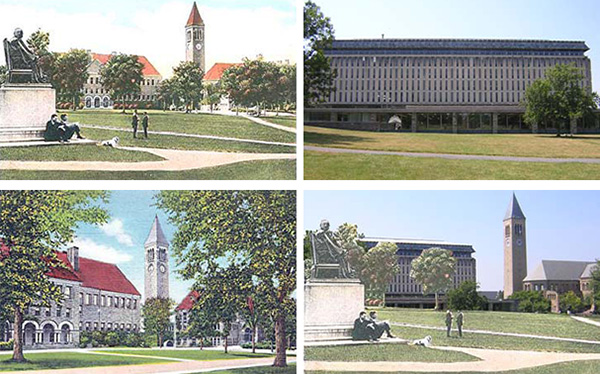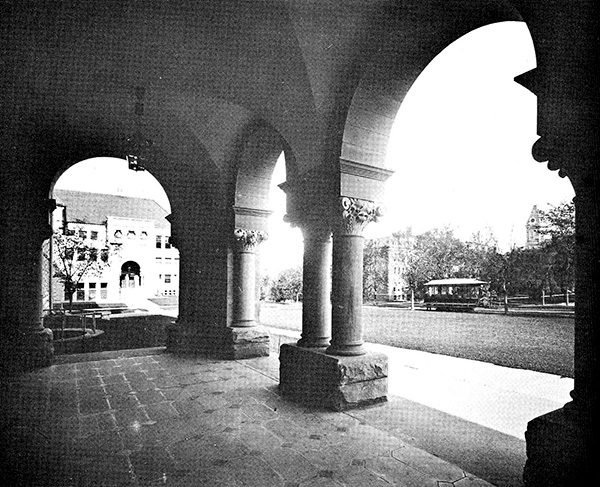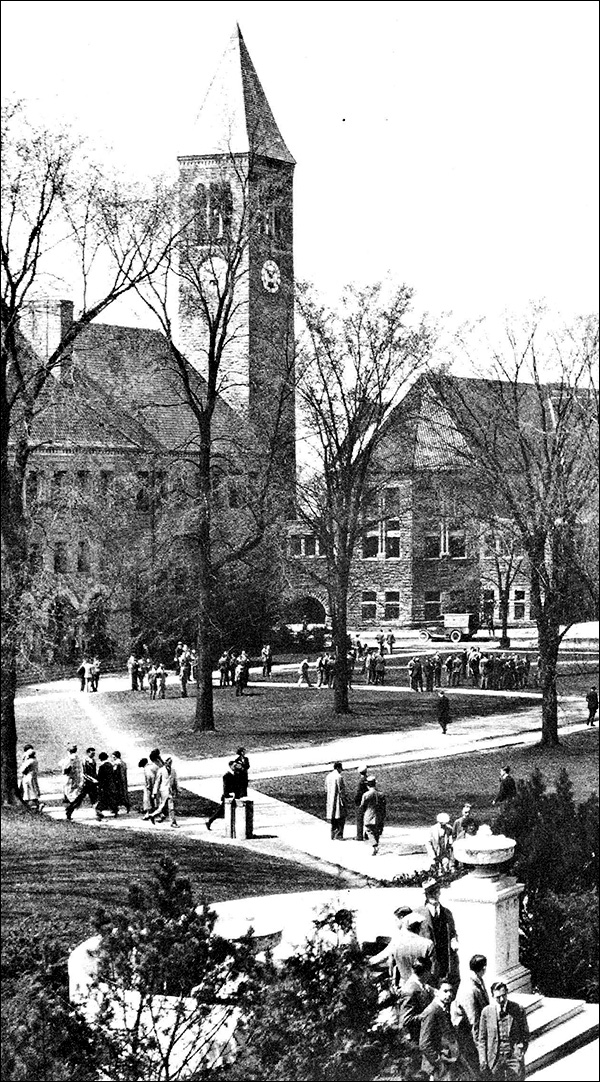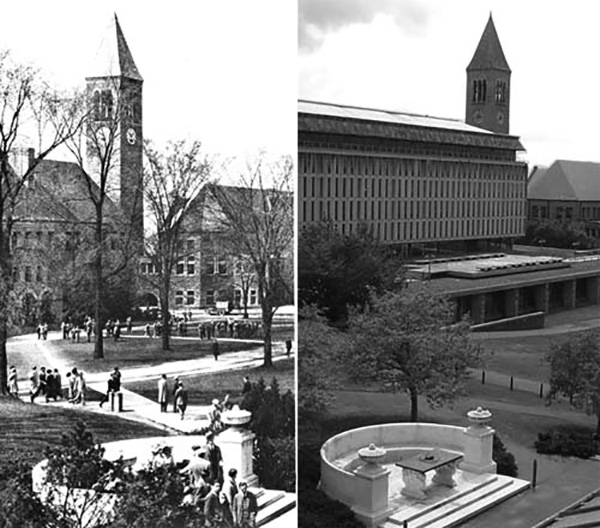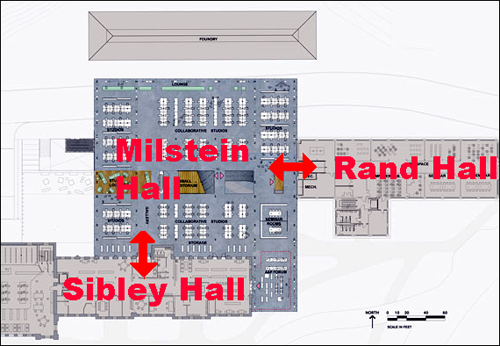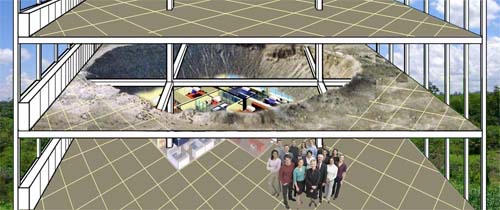I have been shooting video with my low-resolution Flip camcorder to document the construction of Paul Milstein Hall at Cornell University. Two new segments have been put online; links can be found here.
Code compliance issues in E. Sibley Hall, Cornell
Following is a transcription of an email that I wrote to the Dean of the College of Art, Architecture, & Planning at Cornell University on Sept. 6, 2010 (copied to the Assistant Dean for Administration, AA&P; the Project Director for Milstein Hall; and the Building Commissioner and Deputy Building Commissioner of the City of Ithaca) [9/10/10 updates below]:
Portions of East Sibley and Rand Halls are in serious danger of being noncompliant with the NYS Building Code, and their ability to remain occupied for library, studio/classroom, and office use may be in jeopardy.
Once the floor/roof structure of Milstein Hall is in place, two things immediately occur that threaten the continued occupation of the adjacent, connected buildings.
First, all covered space under the structure of Milstein Hall counts as building area for Sibley Hall whether or not those spaces are enclosed, since a fire barrier is not yet in place to separate the two structures. Under these current circumstances, East Sibley Hall contains floors whose areas — that is, the combined, unseparated, floor areas of East Sibley and Milstein Halls — exceed that allowed by the Code, given the limits imposed by the governing V-B construction type for Sibley Hall.
Second, once the floor/roof structure of Milstein Hall is in place, the windows in Sibley Hall under these covered spaces no longer function as openable windows for the purpose of natural ventilation. I understand that Cornell and City of Ithaca Code Enforcement officials have challenged this contention, but I must insist that it remains true. As I pointed out previously, the Code limits natural ventilation to windows opening to “yards” or “courts.” Yards and courts must be “uncovered space, unobstructed to the sky” (see chapter 2 definitions in the Code). The Code does not permit windows used for natural ventilation to open into any other type of spatial geometry, whether or not “outdoor air” can somehow work its way to the window opening. The Commentary to the Code (written for the International Building Code, or IBC, from which the NYS Code derives) is absolutely unambiguous: “In order that adequate air movement will be provided through openings to naturally ventilated rooms, the openings must directly connect to yards or courts with the minimum dimensions specified in Section 1206” (Commentary for Section 1203.4.3 Openings on yards or courts). Since the openings “must directly connect to yards or courts” and since yards and courts must be “uncovered space, unobstructed to the sky,” the East Sibley windows at or below the second-floor of Milstein do not provide natural ventilation. Without mechanical ventilation that meets the criteria specified in the New York State Mechanical Code, the rooms are noncompliant and should not be occupied. In prior emails, I have outlined why the ad hoc provision of room air conditioner units or fans does not satisfy the requirements of the Mechanical Code. Yet aside from such rooms, it is clear that classrooms (e.g., 142-144 ES) or library spaces (e.g., the entire second-floor F.A.L. In E. Sibley) that have absolutely no mechanical ventilation will certainly not meet those Code requirements.
The second floor of Rand Hall, due to changes in the window configuration that have reduced the openable area, also has problems meeting Code criteria for natural ventilation. The current second-floor studio area (field measurements taken 9/3/10, excluding enclosed computer rooms, etc.) encompasses 5,259 square feet. The required vent area from openable windows is 4% of 5,259, or 210.4 square feet. However, the actual available vent area from openable windows, equal to 15 windows times 11.625 square feet of vent area per window, is only 174.4 square feet total. This is clearly noncompliant, and yet no mechanical ventilation is being planned for the studio space [see prior comments].
It is not my intention to speculate as to why East Sibley Hall and the second floor of Rand Hall are being occupied in spite of these apparent Code violations (lack of required ventilation in Rand and East Sibley Halls; and lack of fire barrier protection in East Sibley Hall). But whatever the reasons, the problems need to be addressed. It seems to me that either the noncompliant spaces should be vacated until Sibley/Milstein/Rand Hall is completed, or the twin problems of ventilation and fire protection should be corrected immediately.
Update 1 (9/10/10):
Two passages from NFPA 241: Standard for Safeguarding Construction, Alteration, and Demolition Operations (1996 version quoted here) support my argument about the immediate need for a fire barrier (the NFPA standard mentions “fire wall,” but the same logic applies to a “fire barrier” used as a substitute for a fire wall) between Sibley Hall and Milstein Hall:
1-1.1
Fires during construction, alteration, or demolition operations are an ever-present threat. The fire potential is inherently greater during these operations than in the completed structure due to previous occupancy hazard and the presence of large quantities of combustible materials and debris, together with such ignition sources as temporary heating devices, cutting/welding/plumber’s torch operations, open fires, and smoking. The threat of arson is also greater during construction and demolition operations due to the availability of combustible materials on-site and the open access.
6-6 Fire Cutoffs.
Fire walls and exit stairways, where required for the completed building, shall be given construction priority for installation… [and yes, the fire barrier is required for the completed building].
Update 2 (9/10/10):
I want to clarify that both of the actions I am recommending (mechanical ventilation for E. Sibley Hall rooms adjacent to Milstein Hall; and installation of a fire barrier in all E. Sibley Hall windows adjacent to Milstein Hall) are already part of the Milstein Hall scope of work. The issue is not whether they are required — they are both required and included in the Milstein Hall budget — but whether E. Sibley Hall can remain occupied during construction without these two items being put into place. In my view, the Code is clear on both issues: E. Sibley Hall should not remain occupied without adequate provision for ventilation and fire protection.
Furthermore, since both of these items are already part of the Milstein Hall scope of work, it is absolutely incomprehensible why the project’s phasing plan did not prioritize these two items so that E. Sibley Hall could remain safely occupied during construction. Well, actually, it is not so incomprehensible: the initial plans and specifications submitted to the City of Ithaca Building Department for a building permit included neither a proper fire barrier nor adequate mechanical ventilation for Sibley Hall. It was only after I raised objections through the FEIS comment process that the architects for Milstein Hall extended their fire barrier to the first and basement floors of Sibley Hall, and accepted the need for mechanical ventilation in Sibley Hall (after deciding to put fixed fire-rated glazing in all E. Sibley windows adjacent to Milstein). These architects still have not admitted that natural ventilation from windows under Milstein Hall is no longer a possibility given Code requirements for “yards” and “courts” adjacent to all windows used for natural ventilation; and continue to maintain that it is only because of the fixed glazing required for their fire barrier design that mechanical ventilation becomes necessary.
Construction of Milstein Hall
I’ve just posted the first of a series of informal “construction” videos showing how Paul Milstein Hall (OMA/Rem Koolhaas) at Cornell University is being built. The homepage for the anticipated video series is here. Ultimately, I hope to add additional short videos dealing in turn with substructure, superstructure, and enclosure systems.
The first video, “Getting Ready,” shows some of the preliminary site work and underpinning of adjacent buildings that occurred prior to the actual start of foundation work.
These videos are purely educational and informative in nature: after all, in spite of the numerous problems that this building has, some of which I have discussed elsewhere on this blog (also here), it’s construction is actually quite interesting and in many ways unusual.
Given my prior and continuing criticism of the Milstein Hall design, I would like to acknowledge the support for this video project by the College of Architecture, Art & Planning (Dean Kent Kleinman) and the Construction Manager (Welliver McGuire). Of course, there is a contractual stipulation that some form of educational outreach must be provided along with the actual construction of the building — so my video project proposal, having little if any competition from other faculty initiatives, may have been viewed as a necessity to fulfill this contractual obligation. In any case, I appreciate the support I’ve been given. Disclaimer: Any views or opinions expressed on these videos are entirely my own (except where views or opinions are expressed directly by other people appearing in the videos), and are not necessarily the views of Cornell University, OMA, or any of the consultants, subcontractors, or construction managers involved in the construction of Paul Milstein Hall
Note: links to other Milstein posts updated May 5, 2011.
one life
I’ve just made a new video for a song I wrote in 2003 and recorded in 2008. Included is some Flip video footage from the 2009 World Series in which C.C. Sabathia waves off the curve ball and instead throws an unfortunate two-strike fast ball to Chase Utley — cheerleader “Rudy” Giuliani is watching from the stands and Tim McCarver is telling the world how difficult it is to get a two-strike fastball past Mr. Utley. I was lucky enough to film this perfect scene for my verse #3 lyric (“Catcher wants a breaking ball; pitcher’s waving off the call…”). The YouTube video for One Life (Is All You Get) is here. Remixed Dec. 1, 2018.
Rebuild Boardman Hall
The engineering library is to be closed at Cornell, since virtually all library activity in the college is electronic (see Chronicle article here) [UPDATE 8/13/10: two additional libraries at Cornell being consolidated with the ILR library; see Chronicle article here]. The Fine Arts Library is being largely dismantled and moved to Cornell’s library annex, but only in preparation for its rebirth in Rand Hall, a puzzling decision that I criticized in more detail here.
With the need for great quantities of prime library space increasingly in doubt, Cornell’s bad decision to demolish Boardman Hall in 1958 — in order to build the much larger Olin graduate library on the Arts Quad — should now be seriously revisited. This is a unique opportunity to begin planning to heal the wound that was inflicted on the Quad, an opportunity that may never present itself again.
Cornell’s planning and architectural decisions after Word War II have largely been disastrous; in fact, the architectural beauty of the campus is almost entirely due to the pre-WW II infrastructure that remains in place. The Arts Quad, in particular, is one of the greatest such assemblages of buildings in America, and would become absolutely spectacular if its southern edge could once again be defined by Boardman Hall, designed by the same architect, William Henry Miller, who designed Uris Library. Miller was an early graduate of Cornell’s architecture program in the 1870s.
Preserving and enhancing Cornell’s historic buildings and districts has apparently not been a priority. The recent expansion of housing adjacent to the neo-Gothic West Campus dormitories (originally Baker Court, 1916) and beyond Balch Hall in North Campus (1927) has done to these campus quadrants what Olin Library has done to the Arts Quad. It would be a remarkable and unique decision to take advantage of the imminent reduction in library space needs by actually doing something important for the long-term future of the campus.
Cornell’s Fine Arts Library
[numerous updates below: 7/26/11 – 12/12/13; some nonfunctioning links re-directed Feb. 29, 2016]
It is often necessary to anticipate future developments and trends in order to make recommendations for the renovation of building space or the construction of new space. Paul Milstein Hall at Cornell University (Rem Koolhaas, OMA architects) is an example of new construction resulting from an analysis of spatial needs. It is also an example of what can only be called a squandering of resources since these needs could have been met with far less expenditure of such resources.
Part of what didn’t make sense in the planning of Milstein Hall was its connection at the second-floor level to the Fine Arts Library in Sibley Hall. For security reasons, this connection would have been difficult to implement, and it is likely that the doors between Milstein and Sibley Halls would have remained locked and unusable. Cornell would not permit such issues to be considered in the planning for Milstein Hall, so that the decision to link Milstein to the library space always seemed dubious.
On March 24, 2010, I was called to the Dean’s office to discuss his plan to move the Fine Arts Library out of Sibley Hall, replacing it with studio space and faculty offices that are now in Rand Hall. The ultimate aim is to house the Fine Arts Library in Rand Hall. This appeared sensible for at least two reasons. First, it resolves the embarrassment of having Milstein Hall unable to connect with Sibley Hall: with design studios in Sibley and Milstein at the second-floor level, there would no longer be a security issue forcing the interconnecting doors to be locked. Second, Rand Hall appears to be a much stronger building than Sibley, which has always had problems actually supporting book stacks (unless they are spread out in an inefficient manner). Rand, on the other hand, could house books quite efficiently. In other words, Sibley has a wooden floor structure appropriate for studios, classrooms, and offices; while Rand has a steel and reinforced concrete floor system appropriate for heavier loads like libraries. [10/1/11 update: Moving the Fine Arts Library into Rand Hall is problematic for another reason. See my more recent blog post here.]
But Cornell, in its wisdom, did not plan for such a move, and will not pay for it. Apparently, the only way to accomplish this is to use money already being spent by the college to rent space on Esty Street (downtown Ithaca). By implementing an elaborate phasing plan — in which Esty St. studios are moved to Rand Hall’s first floor, displacing faculty offices which are moved into the Fine Arts Library space, displacing books which are moved either into more dense stack areas under the dome, or into the library’s annex — it seems possible to take the Esty St. rent and apply it to the limited (and temporary) renovation of Sibley and Rand Hall as described above. Ultimately, fund-raising would need to occur so that the entire Fine Arts Library (or some portion thereof that is not housed in the annex) could be moved to a suitable home in Rand Hall, with faculty offices moved again (this time to the third floor of Sibley Hall), and studios moved from Rand Hall into Sibley’s second floor as well as into the soon-to-be-completed Milstein Hall.
But this plan raises another question about the future of libraries. When I talked to Dean Kleinman in March 2010, I suggested that the general strategy of reclaiming Sibley for studios and offices seemed to make much sense, especially since the Fine Arts Library could never logically connect directly to Milstein Hall from its current location in Sibley Hall. However, I made the point that, given the rapidly fading importance of physical books in academic life, it might be wise to reconsider whether fund-raising for a new library home in Rand Hall was an appropriate use of resources. Increasingly, books and journals are accessed electronically; this trend is clearly accelerating, especially with devices like Kindles and iPads becoming available in recent years. Many academic books and journals are already available online as “electronic resources” through Cornell’s library system.
A recent article in the Cornell Chronicle dated June 29, 2010 confirms that Cornell’s engineering library at Carpenter Hall is being dismantled effective next year, since it was discovered that “approximately 99 percent of the use of the collection consists of online materials.” [UPDATE 8/13/10: two additional libraries at Cornell are being “re-imagined”: see Chronicle article here.] In fact, what stands between a fully digitized world of knowledge and the ability to gain access to that knowledge is neither technology nor resources per se, but rather an unholy alliance of forces intent on preserving the infrastructure of what is called intellectual property so that the unfettered diffusion of knowledge can continue to be held hostage to the demands of copyright owners.
Here we see before us a classic instance of the relations of production (including the legal infrastructure defining intellectual property) falling far behind the actual means of production (including the digitization of what were previously physical books and journals). It can already be seen how these relations of production are changing in response to the developing reality of the Internet. See, for example, Google vs. Viacom.
Cornell’s College of Architecture, Art & Planning’s Fine Arts Library is one of the nation’s best. Implicit in Dean Kleinman’s plan to create a new mausoleum for the Fine Arts Library’s physical collection is an attempt to preserve this competitive advantage by renovating new space for the collection. But in an age when physical collections of books will have little utility, except as objects admired in book museums, this appears to be another questionable space-allocation decision and points to the past rather than the future. Instead, Cornell should be working to accelerate the digitization of its (and all other) collections, and to participate in movements aiming for the unfettered distribution of all scholarly works in open-access networks.
[July 26, 2011 update] A just-announced partnership between Cornell and Columbia University libraries is revealing in this regard. Anne Kenney, Cornell’s head librarian, characterizes this partnership as “choosing collaboration over competition” (See Chronicle Online 7/15/11 article) as if corporate mergers — increasing market share and operational efficiencies — are ever about “collaboration over competition.” In fact, an undated article on Cornell’s library web site [link no longer works, but article can be found here, dated Oct. 14, 2009] more accurately describes the motivations and results of such a collaboration: “to achieve greater efficiencies and effectiveness” (James G. Neal, VP for Information Services and University Librarian at Columbia) and “to improve the quality of collections and services offered to campus constituencies, redirect resources to emerging needs, and make each institution more competitive in securing government and foundation support.”
The point I made in the last paragraph of this post bears repeating. Treating academic information as property, intellectual or otherwise, is simply insane. It was insane when knowledge was largely embedded in physical objects (books and periodicals) and libraries competed to have the biggest and best collections; but when knowledge is now embedded largely in digital files, the degree of insanity is impossible to exaggerate. The potential exists now to simply share all knowledge. That the Cornell and Columbia libraries (and they are hardly unique in this regard) exploit this potential as a means for competing against all others — for excluding the rest of the world from these resources — is indeed sad.
[update: March 15, 2012] Thinking of knowledge as intellectual property, and therefore as a means of competition (through which one excludes others from that knowledge to gain an advantage), is apparently the lens through which many Cornell faculty view library resources. This came to light in an article in the Cornell Daily Sun today, which stated: “According to the UFLB report, in 2010 Cornell was ranked 43rd in expenditures proportional to faculty members, 15th to students and 35th to Ph.D. fields among the 116 research libraries as assessed by the ARL.”
The idea expressed by faculty members in that article is that “our collection budget needs to stay competitive“; if not, then “we will not have the best library and won’t be successful in bringing the best faculty and students to Cornell.” That this is undoubtedly true is not the point. Rather, what is striking is the apparent lack of interest in creating a free and open-access platform where such knowledge becomes available and universal. After all, much of this knowledge is actually created by members of academic institutions, created without the expectation of remuneration and constrained in its free and universal distribution, not by the wishes of its creators, but by the archaic system of credentialing and publication that has become one of the most counter-productive aspects of academia — except, of course, from the point of view of those few institutions that are able to use this cumbersome and insane system as a means of competition against their peers.
[update: Dec. 12, 2013] Another Cornell library is being reduced in size: “…Mann Library consolidated its stacks onto its second and third floors this summer. The library based its plans to move around stacks on a study that assessed factors like the reduced need for stacks space and the need for more functional office space…” See this Cornell Sun article from Sept 29, 2013 [pdf made from this low-res archival copy].
so long
This is my first recording of an old song that was left unfinished for many years. I had only an idea for the beginning of the first verse and for the chorus, probably about 25 years ago, but never got around to finishing it until now. View the lyrics, production notes, and see the embedded video here, remixed Aug. 26, 2019. Want a dynamic, transcribable chord chart for the song? It’s here.
hole in floor
You’d think it would easy to put a hole in a floor of a building, but it isn’t. The building code (here I’m talking about the International Building Code, or IBC, latest 2009 version) is organized so that code enforcement people can check whether plans for buildings are in compliance with the code, rather than being organized so that architects can figure out what is or is not possible.
I made a calculator to help designers figure out whether their proposed holes, connecting two or more floors in a building, are in compliance with the 2009 IBC (similar to earlier versions). I also provide a more detailed discussion of the logic behind making such holes, with an invitation for those more expert than myself to clarify some puzzling code issues.
Anyone
This new live video of my song, Anyone, is a milestone of sorts: it represents the final recording of all the songs that I wrote in the late 1970s and early 1980s after graduating from college, moving to NYC, and playing with the band, Rollo. Five additional songs that I wrote during this time period were actually recorded in the 1980s for Rollo’s Don’t Look CD, and I don’t intend to record those songs again now. The song was remixed Aug. 18, 2019.
There are one or two other songs that I wrote in my more distant past (high school, to be precise), but I haven’t decided whether to record them. So this means that any new recordings will be either new compositions, old favorite — unrecorded — Rollo songs written by Dan Smullyan in the 1970s and 1980s, or maybe some new Rollo collaborations.
adaptation
I wrote this song in 2003 after seeing the movie, Adaptation (directed by Spike Jonze, screenplay by Charlie Kaufman, with Nicolas Cage, Meryl Streep, and others) and seeing some potential in doing a live musical performance of a song that is being written during the performance itself (an idea inspired by the movie). So the video of my song, Adaptation, is a re-creation of my actual performance of the song for the first time at the ABC Cafe open mic in Ithaca, NY on August 19, 2003. The ABC Cafe recently closed; I made the video by screen-capturing an image from a YouTube video of Evan D Williams performing at the ABC Cafe in 2007, carefully extracting Evan and his band from the image (no one was hurt in the process), and then adding in my performance — shot at home with my low-resolution Flip Camcorder based on a recording I made using GarageBand (both the recording and video made in March 2010). I also filmed myself as the “audience” for the song, again inspired by Nicolas Cage playing both Charlie and brother Donald Kaufman in the movie.
Remixed Aug. 18, 2019.

